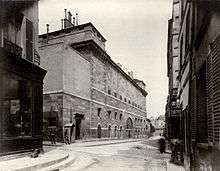Sainte-Pélagie Prison

Sainte-Pélagie was a prison in Paris, in active use from 1790 to 1899. It held many famous prisoners during the French Revolution, with Madame Roland and Grace Dalrymple Elliott being the only female prisoners. After the revolution, the Marquis de Sade was imprisoned here, as was the young mathematician Évariste Galois.
During the July Monarchy, the "April insurgees" were also detained there, and some managed to escape through an underground tunnel. The painter Gustave Courbet was also imprisoned here for his activities in the Paris Commune. He painted a self-portrait titled, Self-Portrait at Ste.-Pélagie.
In literature
In his 1841 novel Ursule Mirouët, Balzac has his character Savinien imprisoned in Sainte-Pélagie for incurring debts in excess of one hundred thousand francs.